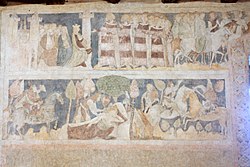
Back كأس لانسلوت Arabic Vulgata artúrica Catalan Lawnslot-Greal Welsh Vulgata-Zyklus German Lanzarote-Grial Spanish Vulgata-sykli Finnish Lancelot-Graal French Lancelot-Graal Galician מחזור הוולגטה HE Lancillotto in prosa Italian
| Lancelot–Grail | |
|---|---|
| Vulgate Cycle | |
 Scenes from the Lancelot Proper depicted in a Polish 14th-century fresco at Siedlęcin Tower | |
| Author(s) | Unknown (in part directly based on Robert de Boron and Chrétien de Troyes) |
| Ascribed to | Self-attributed to Gautier Map |
| Language | Old French |
| Date | c. 1210–1235 |
| Genre | Chivalric romance, pseudo-chronicle |
| Subject | Matter of Britain |
The Lancelot-Grail Cycle (a modern title invented by Ferdinand Lot[1]), also known as the Vulgate Cycle (from the Latin editio vulgata, "common version", a modern title invented by H. Oskar Sommer[2]) or the Pseudo-Map Cycle (named so after Walter Map, its pseudo-author), is an early 13th-century French Arthurian literary cycle consisting of interconnected prose episodes of chivalric romance originally written in Old French. The work of unknown authorship, presenting itself as a chronicle of actual events, retells the legend of King Arthur by focusing on the love affair between Lancelot and Guinevere, the religious quest for the Holy Grail, and the life of Merlin. The highly influential cycle expands on Robert de Boron's "Little Grail Cycle" and the works of Chrétien de Troyes, previously unrelated to each other, by supplementing them with additional details and side stories, as well as lengthy continuations, while tying the entire narrative together into a coherent single tale. Its alternate titles include Philippe Walter's 21st-century edition Le Livre du Graal ("The Book of the Grail").
There is no unity of place within the narrative, but most of the episodes take place in Arthur's kingdom of Logres. One of the main characters is Arthur himself, around whom gravitates a host of other heroes, many of whom are Knights of the Round Table. The chief of them is the famed Lancelot, whose chivalric tale is centered around his illicit romance with Arthur's wife, Queen Guinevere. However, the cycle also tells of adventures of a more spiritual type. Most prominently, they involve the Holy Grail, the vessel that contained the blood of Christ, which is searched for by many members of the Round Table until Lancelot's son Galahad ultimately emerges as the winner of this sacred journey. Other major plotlines include the accounts of the life of Merlin and of the rise and fall of Arthur.
After its completion around 1230–1235, the Lancelot–Grail was soon followed by its major reworking known as the Post-Vulgate Cycle. Together, the two prose cycles with their abundance of characters and stories represent a major source of the legend of Arthur as they constituted the most widespread form of Arthurian literature of the late medieval period, during which they were both translated into multiple European languages and rewritten into alternative variants, including having been partially turned into verse. They also inspired various later works of Arthurian romance, eventually contributing the most to the compilation Le Morte d'Arthur that formed the basis for a modern canon of Arthuriana that is still prevalent today.
- ^ The History of the Holy Grail. Boydell & Brewer Ltd. 2010. ISBN 978-1-84384-224-8.
- ^ Korrel, Peter (January 1984). An Arthurian Triangle: A Study of the Origin, Development, and Characterization of Arthur, Guinevere, and Modred. Brill Archive. ISBN 9004072721.
© MMXXIII Rich X Search. We shall prevail. All rights reserved. Rich X Search